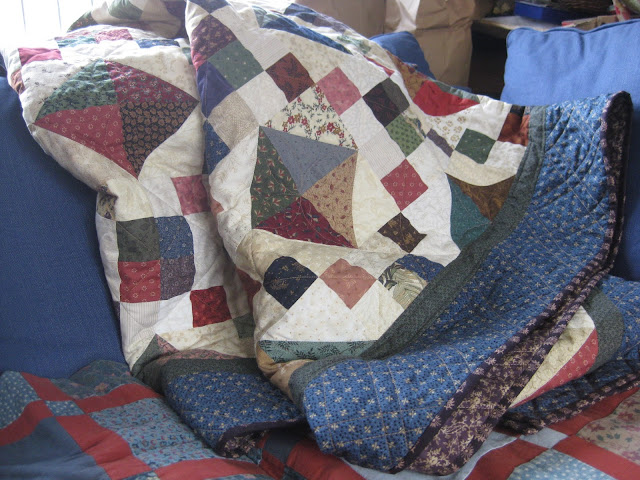I have a finish to share with you all today: not the one I intended as I find I haven't taken any photos of that quilt, so that will be tomorrow's task. However here is another finished quilt from a few weeks ago - you can tell by the grey sky and leafless tree that I photographed it at the beginning of the month.
I actually cannot remember when I pieced this small quilt, though I would guess it is at least 10 years ago. It was one of the first things I made with the new Daiwabo taupe fabrics which were then just becoming available in the UK.
I like to think that my piecing would be more precise if I were to make the quilt again today, so please be kind if you spot any faults. I love flying geese, but I would always now make them oversized and trim with a Bloc_loc ruler to ensure perfect points. However if you squint at the quilt from a distance I guess it's not too bad...
I still really like the fabrics (which is just as well as I still seem to have oodles of taupes left in my stash). There is something about the Japanese taupes, that almost but not quite monochrome quality, which actually makes you really look at the fabrics and see the subtle colours that were there all the time, but which you overlook at first.
I had originally intended to handquilt this one - I would handquilt everything if I could but in practice I handquilt almost nothing - so the quilt has hung around for years, layered and tacked (basted) together. I kept moving it, intending to make a start but never quite getting round to it, and the quilt was therefore rather grubby in places.
I had chosen a plain calico (muslin) backing to show off the hand quilting (my intention was that it would look a bit like a wholecloth quilt on the reverse) and when I re-layered with basting spray after removing the tacking, I stuck with the original plan.
I am really pleased with the quilting, and it just shows what can be achieved with a walking foot and a bit of quilt wrangling. In case you are interested in having a go on your next flying geese quilt, I will describe how I went about it.
I put in the structural quilting lines first, the verticals on either side of the geese strips, burying my thread 'tails' at the top and bottom. Next I stitched down the right hand side of one of the strips of geese in a zigzag, working from the point down the sloping side of the goose triangle, turned the quilt and then worked along the bottom of the triangle towards the mid point, when I turned and went down the slope of the next goose triangle.
Continuing all the way down the strip, I decided not to risk turning the whole quilt and working up the strip in the opposite direction - I felt that would probably create puckers and the quilt would not hang properly. So I finished there and started again at the top of the strip, this time travelling down the left hand side oft the strip of geese and meeting my first line of stitching at the tip/midpoint each time to complete the outlining of the goose triangle.
Once I had done all the strips of geese in this manner and buried all the thread ends, I finished by putting parallel vertical and horizontal lines in the sashing and borders, guided by the woven design of the fabric.
I hope that is comprehensible - if I had any IT skills I could draw the line on to the photo and you would understand instantly, but I don't....sorry! It is not quite as awful a task as it might sound to machine quilt in this way as this is a fairly small quilt (54" x 65") and reasonably easy to turn. I feel it was worth the effort for the amazing texture on the reverse, which does remind me of a wholecloth quilt even if it isn't handquilted!
I am ending this post with two photographs of the quilt taken today, the last day of March and almost a month since the first picture. A beautiful Spring day with the plum tree in blossom. Lots of gardening to do this weekend so quilting will have to take a back seat.
I hope you have a wonderful weekend, however you choose to spend it. Linking to Crazy Mom Quilts for Finish it up Friday.














































